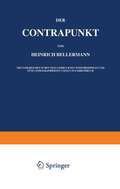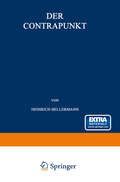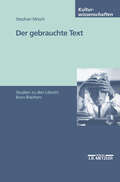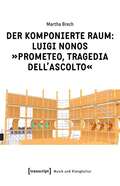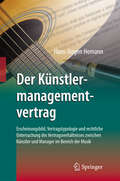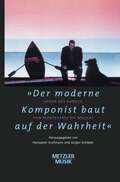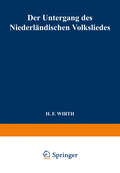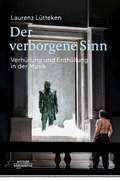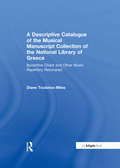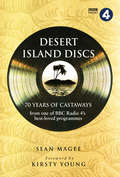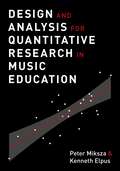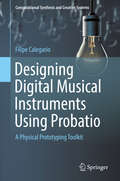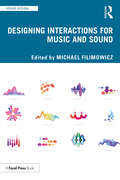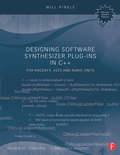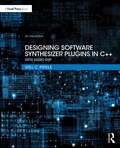- Table View
- List View
Der gebrauchte Text: Studien zu den Libretti Boris Blachers
by Stephan MöschIm Januar 2003 wäre Boris Blacher 100 Jahre alt geworden. Mit seiner "Abstrakten Oper Nr.1" sorgte er für den größten Opernskandal im Nachkriegsdeutschland. Dirigenten wie Furtwängler, Schuricht und Solti setzten seine Werke auf ihre Programme. Heute hingegen wird er kaum mehr aufgeführt. Zu Recht? Allein schon Blachers Position zwischen den Öffnungsperspektiven der 1920er Jahre und der Postmoderne spricht für seine Aktualität. Die vorliegende Studie betrachtet Blachers Umgang mit der Literatur aus wechselnder Perspektive und läßt den Blick dabei zwischen den Disziplinen wandern. Als Be- und Verarbeiter von Texten rückt Blacher ins Blickfeld, als Finder und (dramaturgischer) Erfinder. Neue, zum Teil autographe Quellen werden erstmals ausgewertet. So fächern sich überraschende Aspekte aus dem Opernleben des 20. Jahrhunderts auf.
Der komponierte Raum: Luigi Nonos »Prometeo, tragedia dell'ascolto« (Musik und Klangkultur #48)
by Martha BrechRaum kann integraler Bestandteil einer Komposition sein - davon handelt der dritte Teil der Trilogie zum hörbaren Raum und seiner Technologie. Im Mittelpunkt der Studie steht mit Nonos Prometeo eine der bekanntesten und komplexesten Raumkompositionen des 20. Jahrhunderts. Ausgangspunkt der Untersuchung ist die Rekonstruktion des hörbaren Klangs der im speziellen Holzbau von Renzo Piano verteilt aufgestellten Musiker, Sänger und Lautsprecher bei der Uraufführung 1985. Die Analyse der Raum-Klang-Verhältnisse zeigt, dass die elf Teile des Prometeo aus sich ständig wandelnden Raumklangskulpturen bestehen, die mit den Texten aus Massimo Cacciaris Libretto interagieren.
Der Körper als Vermittler zwischen Musik und: Distanzauslotungen am Beispiel ausgewählter Werke der Neuen Musik (Musik und Klangkultur #54)
by Karolin Schmitt-WeidmannDie künstlerische Hinwendung zu Phänomenen des täglichen Lebens in Verbindung mit der aufkommenden Ästhetisierung des Alltagslebens hat seit den 1960er Jahren zu einer Neubetrachtung des Verhältnisses zwischen Kunst und Nicht-Kunst geführt. In diesem Zusammenhang kommt dem spezifischen Einsatz des Musikerkörpers eine Schlüsselfunktion zu. Karolin Schmitt-Weidmann leitet aus ihm Distanzauslotungen zwischen Kunst und Nicht-Kunst ab und eruiert diese anhand von konkreten Werkbeispielen. Dafür greift sie zurück auf hier erstmalig veröffentlichte Interviews mit Annesley Black, Cathy van Eck, Dieter Schnebel, Vinko Globokar, Hans-Joachim Hespos, Robin Hoffmann und Heinz Holliger zum Verhältnis von Kunst und Lebenswelt.
Der Künstlermanagementvertrag: Erscheinungsbild, Vertragstypologie und rechtliche Untersuchung des Vertragsverhältnisses zwischen Künstler und Manager im Bereich der Musik
by Hans-Jürgen HomannDas Buch befasst sich mit der Vertragspraxis und den Rechtsfragen des Künstlermanagementvertrages im Musikbereich. Schwerpunkt des ersten Teils ist eine umfassende Vertragsanalyse der typischen Regelungen und Pflichtenprogramme zwischen Künstlern und Managern anhand von Praxis- und Musterverträgen. Im zweiten Teil wird die Rechtsnatur typischer Künstlermanagementverträge bestimmt und der Vertrag im System der Schuldverträge verortet. Anschließend werden im dritten Teil die wesentlichen Rechtsprobleme bei der Begründung, Durchführung und Beendigung von Künstlermanagementverträgen untersucht.
"Der moderne Komponist baut auf der Wahrheit": Opern des Barock von Monteverdi bis Mozart
Die Barock-Oper - lange Zeit von den Bühnen verbannt, erlebt inzwischen wieder eine neue Blüte. Von der Geburt des Genres um 1600 in Florentiner Adels- und Gelehrtenkreisen bis zu Mozarts "Zauberflöte" aus dem Jahr 1791 porträtiert der Band die interessantesten barocken Opern und zentrale Werke. Der Bogen reicht von Monteverdi über Purcell und Händel bis zu Mozart, bei dem die barocke Form ihre volle Pracht entfaltet. Namhafte Opernkenner liefern spannende Beiträge zu den 16 wichtigsten Musikdramen.
Der nachschaffende Hörer: Rezeptionsästhetische Studien zur Musik Robert Schumanns
by Ulrike KranefeldWelches Potential bietet ein musikalisches Werk für die schöpferische Auseinandersetzung des Rezipienten? Das Bild eines nachschaffenden Hörers, das Robert Schumann mit Blick auf den Vermittlungszusammenhang von Kunst in seinen musikschriftstellerischen Arbeiten entwirft, findet seine Entsprechung in Schumanns eigenem musikalischen Schaffen: Er geht davon aus, dass der Komponist mit Hilfe einer appellativen künstlerischen Struktur den Hörer nachschaffen lässt und dies auf der Ebene der erklingenden Musik ebenso wie auf der der Notation. So zielen die vorliegenden Studien sowohl auf spezifische Notationsgewohnheiten (etwa schriftsprachliche Zusätze, sprachlich-musikalische Intertextualität oder Titelgebung) als auch auf kompositorische Strukturen seiner Musik (etwa kompositorische Brüche, die Schichtung von Zeithorizonten, der Dualismus von System und Systemlosigkeit oder das Spannungsfeld von Wiederholung und Variante). Gemäß Schumanns ästhetischer Denkfigur eines Ineinanderspiels der Künste bilden ausgewählte Rezeptionsphänomene in Literatur (Jean Paul, Shakespeare/Tieck) und Malerei (Runge, Raphael) den gesamtkünstlerischen Hintergrund, um Robert Schumanns Kompositionen, insbesondere seine Klavierkompositionen der dreißiger Jahre, auf ihr Potential für das Nachschaffen des Hörers zu untersuchen. Dabei finden Analogiebildungen zwischen den Künsten ebenso Raum wie die notwendige Differenzierung angesichts der Heterogenität der Zeichensysteme und medialen Sichtweisen.
Der neue Schauder: Über das Phantastische der musikalischen Romantik
by Christian Kämpf„Es ist ein neuer Schauder, aber keine alte Furcht.“ Jean Pauls Sentenz birgt eine Ästhetik des Phantastischen in nuce. Sie gründet nicht zuletzt auf der Philosophie Friedrich Heinrich Jacobis und zielt auf den Wesenskern der Romantik. Neben Werken von Mozart, Beethoven, Schumann und Wagner werden vor diesem Hintergrund die romantische Zauberoper von Spohr, Weber und Marschner in den Mittelpunkt des Interesses gestellt sowie der sie begleitende musikästhetische Diskurs analysiert, der von Tieck, Hoffmann und Horn, A. B. Marx, Brendel und Pohl angeführt wurde. Entgegen der musikwissenschaftlichen Forschungstradition, die das Phantastische, wo nicht tabuisierte, mindestens trivialisierte, gelangt Kämpf zu einem neuen Verständnis der musikalischen Romantik, wonach sie ihre Zugehörigkeit zur Moderne und ihre Wirkkraft für die Gegenwart nicht des Phantastischen wegen verliert, sondern erst gewinnt.
Der Tonwille: Pamphlets in Witness of the Immutable Laws of Music, Volume I: Issues 1-5 (1921-1923)
by the late Heinrich SchenkerThe groundbreaking analytical techniques of Heinrich Schenker have had a powerful impact on the English-speaking musical world, and their importance, a century after he embarked on his major projects, is greater than ever. A central work in the Schenkerian canon, Der Tonwille, introduced the use of voice-leading graphs that remains a critical tool for many music theorists today. This volume, the first of a two-volume English translation of Schenker's complete original text, makes these important contributions available to English readers for the first time. In the first five "issues" that make up Der Tonwille, Schenker analyzes piano sonatas by Haydn, Mozart, and Beethoven, as well as shorter works including preludes by Bach and various classical keyboard pieces. The volume also includes the first two installments of a large-scale study of Beethoven's Fifth Symphony which, in common with many of the other essays offered here, is comprised of a detailed analysis of the score, a commentary on the sketches and autograph and related textual problems, remarks on performance, and a critique of the literature on the symphony. Most significantly, the essays in this volume are the first that consistently embrace the concept of "Urlinie" by coordinating an explanatory text with a "graph of the Urlinie" for each work discussed. It also contains the most extensive expression of Schenker's outspoken philosophical, political, and artistic beliefs, providing an important cultural perspective from which to view his theoretical work. Under the leadership of William Drabkin, a team of well-regarded musicologists has produced this skilled and lucid translation of Schenker's influential writings, an essential resource for English-reading musicologists and music theorists.
Der Tonwille: Pamphlets in Witness of the Immutable Laws of Music, Volume II
by the late Heinrich SchenkerThis is the second volume of a two-volume translation of Heinrich Schenker's Der Tonwille (1921-24). Among the foremost music theorists of the twentieth century, Schenker's methods of analysis continue to be one of the most important tools of musicology.
Der Untergang des Niederländischen Volksliedes
by H. F. WirthDieser Buchtitel ist Teil des Digitalisierungsprojekts Springer Book Archives mit Publikationen, die seit den Anfängen des Verlags von 1842 erschienen sind. Der Verlag stellt mit diesem Archiv Quellen für die historische wie auch die disziplingeschichtliche Forschung zur Verfügung, die jeweils im historischen Kontext betrachtet werden müssen. Dieser Titel erschien in der Zeit vor 1945 und wird daher in seiner zeittypischen politisch-ideologischen Ausrichtung vom Verlag nicht beworben.
Der verborgene Sinn: Verhüllung und Enthüllung in der Musik
by Laurenz LüttekenEin Sinn, der verborgen oder enthüllt werden kann, ist eine der zentralen Denkfiguren der Neuzeit. Das betrifft auch die Frage, was Musik eigentlich sei. Je stärker man darüber nachgedacht hat, desto brüchiger, changierender ist die Annahme von einem substantiellen Wesenskern der Musik geworden. In diesem Buch geht es nicht um ästhetische oder theoretische Überlegungen dazu, sondern um die Frage, ob und auf welche Weise komponierte Musik sich selbst zum Gegenstand macht und so möglicherweise etwas von ihrem Kern preisgibt. Die optischen Metaphern von Verhüllung und Enthüllung erweisen sich dabei als ebenso hilfreich wie anschaulich. In einer Reihe von Beispielen, die vom 17. bis in die Gegenwart reichen, wird das Phänomen in seiner ganzen Vielfalt beschrieben. Dabei geht es nicht nur um Opern von Mozart bis Strauss, sondern auch um Monteverdis Vokalmusik, Haydns „Schöpfung“, die Sinfonien Bruckners oder Ligetis Etüden.
Der Wahn des Gesamtkunstwerks: Richard Wagners politisch-ästhetische Utopie
by Udo Bermbach"Im Kunstwerk werden wir Eins sein", verheißt Richard Wagner. Leitmotivartig zieht sich dieser Satz durch Wagners Werk und seine Vision einer "ästhetischen Weltordnung". Kunst und Politik werden dabei untrennbar miteinander verwoben. Ein demokratisiertes Publikum soll ein Gesamtkunstwerk erleben, in dem die Einzelkünste zum Musikdrama verschmelzen. Wagner knüpft mit seinem Modell an die antike Polis an, die er idealtypisch in der Moderne wiederbeleben will. In die Neuauflage des revolutionären Wagner-Buchs lässt der Autor weitere überraschende und umfangreiche Analysen u.a. zu Wagners Antisemitismus einfließen.
A Descriptive Catalogue of the Musical Manuscript Collection of the National Library of Greece: Byzantine Chant and Other Music Repertory Recovered
by DianeH. Touliatos-MilesThe National Library of Greece (Ethnike Bibliothike tes Ellados) is one of the richest depositories of Byzantine musical manuscripts and is surpassed by its holdings in Greece only by the multitude of manuscripts found in the monasteries of Mount Athos. In spite of being such a rich archive, the National Library has never published a catalogue of its musical manuscripts - not all of which are Byzantine or Greek. It is the purpose of this catalogue to recover or, in some instances, to present for the first time the repertory of the musical sources of the library. This project has been twelve years in the making for Professor Diane Touliatos, involving the discovery and detailed cataloguing of all 241 Western, Ancient Greek, and Byzantine music manuscripts. Not all of these are from Athens or modern Greece, but also encompass Turkey, the Balkans, Italy, Cyprus, and parts of Western Europe. This variety underlines the importance of the catalogue for identifying composers, music and performance practice of different locales. The catalogue includes a detailed listing of the contents as written in the original language as well as the titles of compositions (and/or incipits) with composers, modal signatures, other attributions and information on performance practice. Each manuscript entry includes a commentary in English indicating important highlights and its significance. There is a substantive English checklist that summarizes the contents of each manuscript for non-Greek readers. A bibliography follows containing pertinent citations where the manuscript has been used in references. There is also a glossary that defines terms for the non-specialist. Examples of some of the manuscripts will be photographically displayed. The catalogue will enlighten musicologists and Byzantinists of the rich and varied holdings of some of the most important musical manuscripts in existence, and stimulate more interest and investigation of these sources. As such, it will fill a major ga
A Descriptive Catalogue of the Musical Manuscript Collection of the National Library of Greece: Byzantine Chant and Other Music Repertory Recovered
by DianeH. Touliatos-MilesThe National Library of Greece (Ethnike Bibliothike tes Ellados) is one of the richest depositories of Byzantine musical manuscripts and is surpassed by its holdings in Greece only by the multitude of manuscripts found in the monasteries of Mount Athos. In spite of being such a rich archive, the National Library has never published a catalogue of its musical manuscripts - not all of which are Byzantine or Greek. It is the purpose of this catalogue to recover or, in some instances, to present for the first time the repertory of the musical sources of the library. This project has been twelve years in the making for Professor Diane Touliatos, involving the discovery and detailed cataloguing of all 241 Western, Ancient Greek, and Byzantine music manuscripts. Not all of these are from Athens or modern Greece, but also encompass Turkey, the Balkans, Italy, Cyprus, and parts of Western Europe. This variety underlines the importance of the catalogue for identifying composers, music and performance practice of different locales. The catalogue includes a detailed listing of the contents as written in the original language as well as the titles of compositions (and/or incipits) with composers, modal signatures, other attributions and information on performance practice. Each manuscript entry includes a commentary in English indicating important highlights and its significance. There is a substantive English checklist that summarizes the contents of each manuscript for non-Greek readers. A bibliography follows containing pertinent citations where the manuscript has been used in references. There is also a glossary that defines terms for the non-specialist. Examples of some of the manuscripts will be photographically displayed. The catalogue will enlighten musicologists and Byzantinists of the rich and varied holdings of some of the most important musical manuscripts in existence, and stimulate more interest and investigation of these sources. As such, it will fill a major ga
Desert Island Discs: 70 Years Of Castaways
by Sean Magee Kirsty Young‘For seventy years now Desert Island Discs has managed that rare feat – to be both enduring and relevant. By casting away the biggest names of the day in science, business, politics, showbiz, sport and the arts, it presents a cross-sectional snapshot of the times in which we live. As the decades have passed, the programme has kept pace; never frozen in time yet always, somehow, comfortingly the same.’ Kirsty YoungBBC Radio 4’s Desert Island Discs celebrates its seventieth birthday in 2012. Since the programme’s deviser Roy Plomley interviewed comedian Vic Oliver in January 1942, nearly 3,000 distinguished people from all walks of life have been stranded on the mythical island, accompanied by only eight records, one book and a luxury.Here the story of one of BBC Radio 4’s favourite programmes is chronicled through a special selection of castaways.Roy Plomley, inventor of the programme as well as its presenter for over forty years, quizzes the young Cliff Richard about ‘these rather frenzied movements’ the 1960s pop sensation makes on the stage. Robert Maxwell tells Plomley’s successor Michael Parkinson that ‘I will have left the world a slightly better place by having lived in it.’ Diana Mosley assures Sue Lawley that Adolf Hitler was ‘extraordinarily fascinating’ and had mesmeric blue eyes. And Johnny Vegas tugs Kirsty Young’s heart-strings with his account of a childhood so impoverished that family pets were fair game: ‘My dad had always claimed that rabbits were livestock, but we’d never eaten one before.’Desert Island Discs is much more than a radio programme. It is a unique and enduringly popular take on our lives and times – and this extensively illustrated book tells in rich detail the colourful and absorbing story of an extraordinary institution.
DESIGN & ANALY QUANTIT RES MUSIC EDU C
by Peter Miksza Kenneth ElpusIn recent years, academics and professionals in the social sciences have forged significant advances in quantitative research methodologies specific to their respective disciplines. Although new and sophisticated techniques for large-scale data analyses have become commonplace in general educational, psychological, sociological, and econometric fields, many researchers in music education have yet to be exposed to such techniques. Design and Analysis of Quantitative Research in Music Education is a comprehensive reference for those involved with research in music education and related fields, providing a foundational understanding of quantitative inquiry methods. Authors Peter Miksza and Kenneth Elpus update and expand the set of resources that music researchers have at their disposal for conceptualizing and analyzing data pertaining to music-related phenomena. This text is designed to familiarize readers with foundational issues of quantitative inquiry as a point of view, introduce and elaborate upon issues of fundamental quantitative research design and analysis, and expose researchers to new, innovative, and exciting methods for dealing with complex research questions and analyzing large samples of data in a rigorous and thorough manner. With this resource, researchers will be better equipped for dealing with the challenges of the increasingly information-rich and data-driven environment surrounding music education. An accompanying companion website provides valuable supplementary exercises and videos.
Design and Analysis for Quantitative Research in Music Education
by Peter Miksza Kenneth ElpusIn recent years, academics and professionals in the social sciences have forged significant advances in quantitative research methodologies specific to their respective disciplines. Although new and sophisticated techniques for large-scale data analyses have become commonplace in general educational, psychological, sociological, and econometric fields, many researchers in music education have yet to be exposed to such techniques. Design and Analysis of Quantitative Research in Music Education is a comprehensive reference for those involved with research in music education and related fields, providing a foundational understanding of quantitative inquiry methods. Authors Peter Miksza and Kenneth Elpus update and expand the set of resources that music researchers have at their disposal for conceptualizing and analyzing data pertaining to music-related phenomena. This text is designed to familiarize readers with foundational issues of quantitative inquiry as a point of view, introduce and elaborate upon issues of fundamental quantitative research design and analysis, and expose researchers to new, innovative, and exciting methods for dealing with complex research questions and analyzing large samples of data in a rigorous and thorough manner. With this resource, researchers will be better equipped for dealing with the challenges of the increasingly information-rich and data-driven environment surrounding music education. An accompanying companion website provides valuable supplementary exercises and videos.
Designing Digital Musical Instruments Using Probatio: A Physical Prototyping Toolkit (Computational Synthesis and Creative Systems)
by Filipe CalegarioThe author presents Probatio, a toolkit for building functional DMI (digital musical instruments) prototypes, artifacts in which gestural control and sound production are physically decoupled but digitally mapped. He uses the concept of instrumental inheritance, the application of gestural and/or structural components of existing instruments to generate ideas for new instruments. To support analysis and combination, he then leverages a traditional design method, the morphological chart, in which existing artifacts are split into parts, presented in a visual form and then recombined to produce new ideas. And finally he integrates the concept and the method in a concrete object, a physical prototyping toolkit for building functional DMI prototypes: Probatio. The author's evaluation of this modular system shows it reduces the time required to develop functional prototypes. The book is useful for researchers, practitioners, and graduate students in the areas of musical creativity and human-computer interaction, in particular those engaged in generating, communicating, and testing ideas in complex design spaces.
Designing Interactions for Music and Sound (Sound Design)
by Michael FilimowiczDesigning Interactions for Music and Sound presents multidisciplinary research and case studies in electronic music production, dance-composer collaboration, AI tools for live performance, multimedia works, installations in public spaces, locative media, AR/VR/MR/XR and health. As the follow-on volume to Foundations in Sound Design for Interactive Media, the authors cover key practices, technologies and concepts such as: classifications, design guidelines and taxonomies of programs, interfaces, sensors, spatialization and other means for enhancing musical expressivity; controllerism, i.e. the techniques of non-musician performers of electronic music who utilize MIDI, OSC and wireless technologies to manipulate sound in real time; artificial intelligence tools used in live club music; soundscape poetics and research creation based on audio walks, environmental attunement and embodied listening; new sound design techniques for VR/AR/MR/XR that express virtual human motion; and the use of interactive sound in health contexts, such as designing sonic interfaces for users with dementia. Collectively, the chapters illustrate the robustness and variety of contemporary interactive sound design research, creativity and its many applied contexts for students, teachers, researchers and practitioners.
Designing Interactions for Music and Sound (Sound Design)
by Michael FilimowiczDesigning Interactions for Music and Sound presents multidisciplinary research and case studies in electronic music production, dance-composer collaboration, AI tools for live performance, multimedia works, installations in public spaces, locative media, AR/VR/MR/XR and health. As the follow-on volume to Foundations in Sound Design for Interactive Media, the authors cover key practices, technologies and concepts such as: classifications, design guidelines and taxonomies of programs, interfaces, sensors, spatialization and other means for enhancing musical expressivity; controllerism, i.e. the techniques of non-musician performers of electronic music who utilize MIDI, OSC and wireless technologies to manipulate sound in real time; artificial intelligence tools used in live club music; soundscape poetics and research creation based on audio walks, environmental attunement and embodied listening; new sound design techniques for VR/AR/MR/XR that express virtual human motion; and the use of interactive sound in health contexts, such as designing sonic interfaces for users with dementia. Collectively, the chapters illustrate the robustness and variety of contemporary interactive sound design research, creativity and its many applied contexts for students, teachers, researchers and practitioners.
Designing Software Synthesizer Plug-Ins in C++: For RackAFX, VST3, and Audio Units
by Will PirkleBridging the gap from theory to programming, Designing Software Synthesizer Plug-Ins in C++ For RackAFX, VST3 and Audio Units contains complete code for designing and implementing software synthesizers for both Windows and Mac platforms. You will learn synthesizer operation, starting with the underlying theory of each synthesizer component, and moving on to the theory of how these components combine to form fully working musical instruments that function on a variety of target digital audio workstations (DAWs). Containing some of the latest advances in theory and algorithm development, this book contains information that has never been published in textbook form, including several unique algorithms of the author’s own design. The book is broken into three parts: plug-in programming, theory and design of the central synthesizer components of oscillators, envelope generators, and filters, and the design and implementation of six complete polyphonic software synthesizer musical instruments, which can be played in real time. The instruments implement advanced concepts including a user-programmable modulation matrix. The final chapter shows you the theory and code for a suite of delay effects to augment your synthesizers, introducing you to audio effect processing. The companion website, www.focalpress.com/cw/pirkle, gives you access to free software to guide you through the application of concepts discussed in the book, and code for both Windows and Mac platforms. In addition to the software, it features bonus projects, application notes, and video tutorials. A reader forum, monitored by the author, gives you the opportunity for questions and information exchange.
Designing Software Synthesizer Plug-Ins in C++: For RackAFX, VST3, and Audio Units
by Will PirkleBridging the gap from theory to programming, Designing Software Synthesizer Plug-Ins in C++ For RackAFX, VST3 and Audio Units contains complete code for designing and implementing software synthesizers for both Windows and Mac platforms. You will learn synthesizer operation, starting with the underlying theory of each synthesizer component, and moving on to the theory of how these components combine to form fully working musical instruments that function on a variety of target digital audio workstations (DAWs). Containing some of the latest advances in theory and algorithm development, this book contains information that has never been published in textbook form, including several unique algorithms of the author’s own design. The book is broken into three parts: plug-in programming, theory and design of the central synthesizer components of oscillators, envelope generators, and filters, and the design and implementation of six complete polyphonic software synthesizer musical instruments, which can be played in real time. The instruments implement advanced concepts including a user-programmable modulation matrix. The final chapter shows you the theory and code for a suite of delay effects to augment your synthesizers, introducing you to audio effect processing. The companion website, www.focalpress.com/cw/pirkle, gives you access to free software to guide you through the application of concepts discussed in the book, and code for both Windows and Mac platforms. In addition to the software, it features bonus projects, application notes, and video tutorials. A reader forum, monitored by the author, gives you the opportunity for questions and information exchange.
Designing Software Synthesizer Plugins in C++: With Audio DSP
by Will C. PirkleDesigning Software Synthesizer Plugins in C++ provides everything you need to know to start designing and writing your own synthesizer plugins, including theory and practical examples for all of the major synthesizer building blocks, from LFOs and EGs to PCM samples and morphing wavetables, along with complete synthesizer example projects. The book and accompanying SynthLab projects include scores of C++ objects and functions that implement the synthesizer building blocks as well as six synthesizer projects, ranging from virtual analog and physical modelling to wavetable morphing and wave-sequencing that demonstrate their use. You can start using the book immediately with the SynthLab-DM product, which allows you to compile and load mini-modules that resemble modular synth components without needing to maintain the complete synth project code. The C++ objects all run in a stand-alone mode, so you can incorporate them into your current projects or whip up a quick experiment. All six synth projects are fully documented, from the tiny SynthClock to the SynthEngine objects, allowing you to get the most from the book while working at a level that you feel comfortable with. This book is intended for music technology and engineering students, along with DIY audio programmers and anyone wanting to understand how synthesizers may be implemented in C++.
